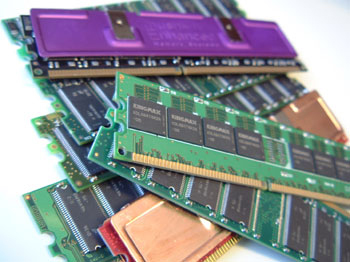Beginners Guides: RAM, Memory and Upgrading
What is memory? Well, let me think... - Version 1.0.2
Modern computer processors can
perform several billion operations per second, creating and changing incredible amounts of
data in a short period of time. To perform at this level, they have to be
able to juggle the information they process, to have someplace to store it until it
is needed again for modification or reference.
As a metaphor, the more
jobs a technician takes on at once, the more bench space they are going to need
to place the components they are assembling, and the more shelf space they will
need to place the finished products. Similarly, computers need space to store
data while they are working on it, and space to store data that is not being
worked on, but will be needed in the future. This is provided by RAM (Random
Access Memory) and hard disk drives respectively.
Computers have a
memory structure which can be easily (if somewhat sloppily) compared to the human
brain. The hard drive provides long-term memory storage similar to our long-term memories,
a place where data is put to be permanently stored. RAM
(Random Access Memory) provides a pallet that the computer can work from in
normal operation, similar to our short-term memory. It holds information that is essential now
but may or may not be transferred to long-term memory, depending on need.
Modern processors also include a memory cache, a
comparatively small amount of high-speed memory which stores the data that is
currently being used most often. This could be compared to our awareness, the
memory that connects one moment to the next and keeps us doing what we were
doing a second ago.
 Random
Access Memory (RAM) can be thought
of as the short-term memory, in the sense that once the power
is turned off, all information stored there is not saved. All modern computers have
hard drives which store data permanently as magnetic information, but even with the improved speed of
today's hard drive technology. Hard drives are still too slow to keep up with
the needs of the processor since it can operate on considerably more
information per second than can possibly be transferred to and from the
hard drive.
Random
Access Memory (RAM) can be thought
of as the short-term memory, in the sense that once the power
is turned off, all information stored there is not saved. All modern computers have
hard drives which store data permanently as magnetic information, but even with the improved speed of
today's hard drive technology. Hard drives are still too slow to keep up with
the needs of the processor since it can operate on considerably more
information per second than can possibly be transferred to and from the
hard drive.
This is where the need for a fast, short-term memory solution comes in,
a memory space that provides very fast access for the processor so
data can be written and read as needed without slowing down the
system appreciably.
RAM
fulfills this need, specifically DRAM (Dynamic RAM), the template for all modern
memory types.
DRAM consists of semiconductor chips arranged on
a small circuit board, each containing a logical arrangement of cells laid
out in rows and columns. These cells use a combination of a capacitor and a
transistor to achieve one of two states, filled with electrons (1) or empty (0),
thus allowing binary (digital) information to be stored.
The dynamic
aspect of this type of memory is that it needs to be constantly refreshed
with an electric charge to keep its information stored. When the computer
is turned off, all data in the DRAM is lost. In all modern desktop computers,
DRAM can be added directly to the motherboard in the form of memory modules,
a circuit board with mounted memory DRAM chips.
Types of memory
There are three main types of
memory in common use today. SDRAM (Synchronous Dynamic RAM), DDR-SDRAM (Double
Data Rate SDRAM) and RDRAM (RAMBUS Dynamic RAM). This article will detail all
three, though it should be mentioned at this time that DDR-SDRAM in its various
forms is by far the dominant type in today's PC market.

